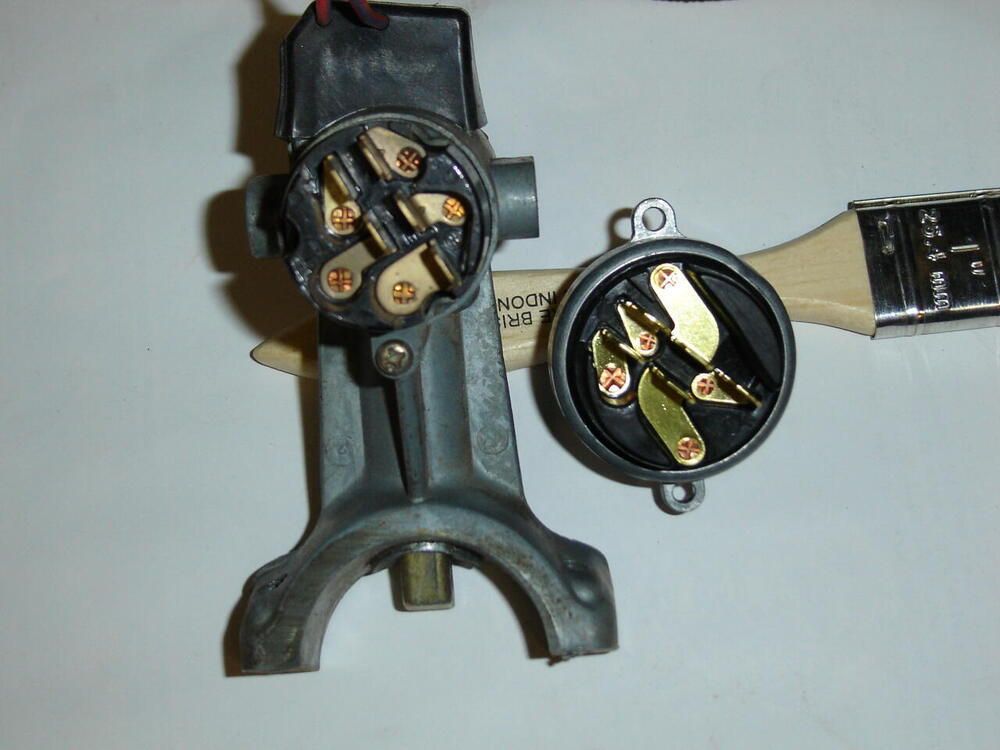Everything posted by Captain Obvious
-
1971 HLS30-14938 "Lily" build
So the unusual nature of this issue has me intrigued. I know you said you were going to have the combo switch thing rebuilt, but in the meantime, I had a question. Are you running an old style single screw mount ignition switch, or has the whole assy been replaced sometime over the years with the newer two screw style? Here's a hoovered pic of the difference. Older single screw mount on the left, newer two screw mount on the right:
-
Restoration of BringaTrailer 240z - HLS30-35883
Yeah, that temp gauge is a little disconcerting. Even if your logical mind knows that it's an instrumentation issue and not a real temperature issue, just looking at that thing would drive me nuts. So while you are in there, are you happy with the location of the oil pressure readings? Because if you're going to be into the guts of the gauge, that would be the opportunity to adjust the OIL as well.
-
1971 HLS30-14938 "Lily" build
I figured. But it was worth a look!
-
1971 HLS30-14938 "Lily" build
So I did a little thinking and looking and I have a theory.... This time a little less knee-jerk. If the brake light only comes on in the LOCK position, my theory is that you plugged the connector onto the back of the ignition switch 180 degrees out of position. I don't have a harness here to see if that's physically possible or if things are mechanically keyed, but if there is no key, you might have done that? I admit, it would be unlike you to do something like that, but who knows... In a flurry of hurried activity, not lining up the unpopulated connector cavity and all that? And if you did, it can cause exactly what you described.
-
1971 HLS30-14938 "Lily" build
Oh wait... Sorry, I missed that detail. The brake light is on when the key is in the OFF position!!! So all that stuff I wrote... Forget all that. It's more complicated than just a brake warning switch. So I'll shut up here and wait while @SteveJ provides some REAL help instead of the knee-jerk blather I posted above. I mean, your brake warning switch may still be screwed up, but there are some electrical gremlins at work here too.
-
1971 HLS30-14938 "Lily" build
Short answer? Because your brake failure switch is indicating a brake failure. In other words, the switch is closed. Long answer? I'll let @SteveJ work you through it! But I suspect the problem in inside the brake switch. Something like your little slidey piston is all gummed up and stuck on the "fail" position: Or maybe one of your tiny metering orifice holes is gummed shut with 50 years of gelatinized brake fluid and deteriorated rubber:
-
Tank to pump hose routing
Yeah, it's always it's a little risky to go running more fuel lines all over, but I really think you need to do that. Make sure you have a good fire extinguisher with you, just in casel. In the meantime, I'll think a little about where to go next if you come back and tell us the fuel pressure numbers are just fine under load even when the engine isn't running properly.
-
Needle Is Too High On Temp Gauge
Then, in this pic... You see the little screw? That's an adjustment screw for the gauge. Make the contacts tighter, it should read higher. Make the contacts looser, it should read lower:
-
Needle Is Too High On Temp Gauge
First, have a look at this thread that details how the gauges work:
-
Tank to pump hose routing
It's not the same. It takes a lot less fuel sitting still at 3K sitting than driving around. The load is so much lower. Try this... Sit in the driver's seat and with the engine running, push the gas pedal down until the engine is spinning at 3K. Note how little pedal it takes to do that. Way less pedal to do that than do drive around under load. Hope you can make some headway with this issue. I'm sure you're tired of dealing with it.
-
Tank to pump hose routing
Those numbers all look fine. I am a little concerned that you would be loosing 2 psi between the pump and the engine compartment, but that could just be different measurement methods or gauges. And those numbers are under low (or no) fuel demand conditions. I'm still wondering about some delivery issue that is only apparent under higher load conditions. Maybe you could tape your phone inside the engine compartment aimed at the gauge and take a short video? So about that whole front fire thing and looking for vacuum leaks... Make sure you take a good look at the rubber boot that fits between the AFM and the throttle body and all the associated hoses connected to it. PCV, etc. If you popped a crack in that boot, it'll run lean. Or if you damaged your PCV hose it will also.
-
Tank to pump hose routing
Me too. You shouldn't see 36 psi at idle under normal conditions. You should see 36 minus intake manifold vacuum. Can you double check these numbers? Zed-head questioned the numbers found here, and I agree. I don't get how the idle is richer with the line connected, and ZH questioned how the car can be having a performance problem with WOT numbers like you're getting. - after hose change (with FPR vacuum line connected): idle 14.7, cruise 16-19ish, WOT 13.7 - after hose change (with FPR vacuum line dis-connected): idle 16.9, cruise 15ish, WOT 12.8 There is a small inlet screen on the stock fuel pump. Is there anything like that in your aftermarket replacement?
-
Sourcing a L24 engine for rebuild in Pacific Northwest area
Wow. Glad you're still around, but what a chain of events! Hope it's greener pastures from here!!
-
Seeking proper choke function with the 4 screw type
Arrrrrgh!!!
-
Tank to pump hose routing
At idle, you SHOULD be seeing around 30 psi. If you goose the throttle, it should shoot up to 36 for a brief period. But at steady state idle, a reading of 30 is not a problem. That fuel pressure spec is a differential reading. Think about it this way.... There should always be 36psi across the injector. Fuel line pressure on the inlet side of the injector, and intake manifold pressure (vacuum) on the other. If the manifold vacuum is 17 inches of mercury (which converts to around 6 psi of vacuum). You need to subtract that six psi from the fuel pressure in order to maintain the 36 psi differential. Fuel line pressure - manifold pressure = desired differential across injector (which is 36) 30 - (-6) = 36 << fuel line pressure = 30 When you are at WOT, the intake manifold vacuum is zero: 36 - 0 = 36 << fuel line pressure = 36 Does that make sense?
-
Seeking proper choke function with the 4 screw type
Yup. Set-up to run with the nozzles about 2 1/2 turns down, I measure the same as you. Then with the nozzles turned all the way up, it's closer to 1/2 inch. So it sounds like you're making good progress with the nozzle sticking issue. Cool.
-
Tank to pump hose routing
I don't know what's going on yet, so I'm not ready to let the pump off the hook. Is there a way you can see what happens to the fuel pressure while you're driving?
-
Seeking proper choke function with the 4 screw type
And by "something weird", I mean, maybe the annoyingly complicated nugget of springs and levers and stops etc. has an issue:
-
Seeking proper choke function with the 4 screw type
I measured the nozzle drop on a set of four screw carbs here and (with the nozzle nuts turned all the way up "home") I get about about 1/2 inch. If you're really getting 1" drop on your troublesome nozzles, then there's something weird going on.
-
1971 HLS30-14938 "Lily" build
Done!! Let's hope it doesn't come to that, but if it does, I'm all over it!!
-
Tank to pump hose routing
Hmmm... 38psi with the vacuum line pulled off the FPR sounds good. And 30 psi with that line connected is OK too. Are you able to see the fuel pressure gauge WHILE you are driving? I'm curious to see if the 38 drops significantly when there is more than just a "light idle" load on the engine. In other words... Your fuel system may be able to deliver enough fuel AT IDLE and still maintain 38 psi, but the trick is that it takes a really small amount of fuel to maintain idle. I'm thinking that maybe the system can idle fine at 38, but as soon as the fuel delivery requirements get higher (like when you are driving around), the system doesn't have enough compliance to maintain proper pressure under higher demand conditions. And that's a typical symptom of a restriction somewhere. Fuel filter, clogged check valve, something like that.
-
Seeking proper choke function with the 4 screw type
There is no real adjustability on the max amount that the nozzle drops. Sure, you could bend the #1 lever to potentially change it, but it will put things out of alignment and potentially bind. Maybe someone tweaked yours at some time in the past? You should be able rotate the choke actuation lever all the way to it's stop, and when you release it, the springs involved should be enough to pull the nozzle back up. It should come back up and "snap" against the bottom of the holder nut. I will measure the amount of nozzle drop on a carb here and we can compare notes.
-
1971 HLS30-14938 "Lily" build
Haha!! So we're gonna be rebuilding your engine in the parking lot at zcon!! I call dibs on working on the timing chain and stuff!
-
1971 HLS30-14938 "Lily" build
That turd has to get you both TO and BACK from zcon remember! Unless you're thinking that once you make it, you'll just stay there!
-
Seeking proper choke function with the 4 screw type
Now, the more complicated... The nozzles should not ever stick in the holder. If they are doing that, you need to figure out what is going on with that before you move forward. I've seen grit in the nozzle holes. Grit in the actuating mechanism. Burrs on stuff. Varnish on stuff. Plating too thick interfering with stuff that should rotate. Plating flaking off and becoming grit. Lack of lube where necessary. Incorrect needle alignment. Incorrect assembly of the little springs... But the point is, you need to make sure the nozzles return to full UP home when the choke cable isn't pushing them down. And can we work on the adjustment of the throttle plate opening amount when you get the rest of the stuff under control?










